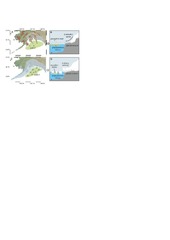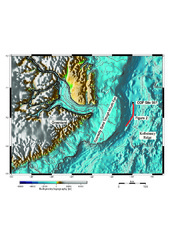Blar i forfatter "Forwick, Matthias"
-
Amino acid racemization in Quaternary foraminifera from the Yermak Plateau, Arctic Ocean
West, Gabriel; Kaufman, Darrell S; Muschitiello, Francesco; Forwick, Matthias; Matthiessen, Jens; Wollenburg, Jutta; O’Regan, Matt (Journal article; Tidsskriftartikkel; Peer reviewed, 2019-11-18)Amino acid racemization (AAR) geochronology is a powerful tool for dating Quaternary marine sediments across the globe, yet its application to Arctic Ocean sediments has been limited. Anomalous rates of AAR in foraminifera from the central Arctic were reported in previously published studies, indicating that either the rate of racemization is higher in this area, or inaccurate age models were used ... -
Changes in sea ice cover and ice sheet extent at the Yermak Plateau during the last 160 ka - Reconstructions from biomarker records
Kremer, A; Stein, R; Fahl, K.; Ji, Z; Yang, Z; Wiers, Steffen; Matthiessen, J; Forwick, Matthias; Löwemark, Ludvig; O'Regan, M; Chen, J; Snowball, Ian (Journal article; Tidsskriftartikkel; Peer reviewed, 2018-02-15)The Yermak Plateau is located north of Svalbard at the entrance to the Arctic Ocean, i.e. in an area highly sensitive to climate change. A multi proxy approach was carried out on Core PS92/039-2 to study glacial-interglacial environmental changes at the northern Barents Sea margin during the last 160 ka. The main emphasis was on the reconstruction of sea ice cover, based on the sea ice proxy ... -
Cordilleran ice-sheet growth fueled primary productivity in the Gulf of Alaska, northeast Pacific Ocean
Müller, Juliane; Romero, Oscar; Cowan, Ellen A.; McClymont, Erin L.; Forwick, Matthias; Asahi, Hirofumi; März, Christian; Moy, Christopher M.; Suto, Itsuki; Mix, Alan; Stoner, Joseph (Journal article; Tidsskriftartikkel; Peer reviewed, 2018-02-15)Fertilization of the ocean by eolian dust and icebergs is an effective mechanism to enhance primary productivity. In particular, high-nutrient, low-chlorophyll (HNLC) areas where phytoplankton growth is critically iron-limited, such as the subarctic Pacific Ocean and the Southern Ocean, are proposed to respond to increases in bioavailable Fe supply with enhanced phytoplankton productivity and carbon ... -
Depositional processes on the distal Scoresby Trough Mouth Fan (ODP Site 987): Implications for the Pleistocene evolution of the Scoresby Sund Sector of the Greenland Ice Sheet
Laberg, Jan Sverre; Rydningen, Tom Arne; Forwick, Matthias; Husum, Katrine (Journal article; Tidsskriftartikkel; Peer reviewed, 2017-11-28)The investigation of trough mouth fans (TMFs), important paleoclimatic archives on mid- and high-latitude continental margins, has so far mainly been based on the integration of various types of acoustic data supplemented with short sediments cores. In consequence, sedimentological and chronological data about parts of TMFs deposited prior to the Last Glacial Maximum remains sparse. Here, we re-evaluate ... -
An Early Neogene—Early Quaternary Contourite Drift System on the SW Barents Sea Continental Margin, Norwegian Arctic
Rydningen, Tom Arne; Høgseth, Gert; Lasabuda, Amando Putra Ersaid; Laberg, Jan Sverre; Safronova, Polina; Forwick, Matthias (Journal article; Tidsskriftartikkel; Peer reviewed, 2020-10-30)The onset and evolution of the middle to late Cenozoic “icehouse” world was influenced by the development of the global ocean circulation linking the Norwegian–Greenland Sea-Arctic Ocean to the Atlantic Ocean. The evolution of the early Neogene to early Quaternary Bjørnøyrenna Drift, located at the SW Barents Sea continental margin, shed new light on this important hydrological event. By analyzing ... -
Environmental variability off NE Greenland (western Fram Strait) during the past 10,600 years
Zehnich, Marc; Spielhagen, Robert F.; Bauch, Henning A.; Forwick, Matthias; Hass, Christian; Palme, Tina; Stein, Ruediger; Syring, Nicole (Journal article; Tidsskriftartikkel; Peer reviewed, 2020-08-13)To reconstruct the climatic and paleoceanographic variability offshore Northeast Greenland during the last ~10 ka with multidecadal resolution, sediment core PS93/025 from the outermost North-East Greenland continental shelf (80.5°N) was studied by a variety of micropaleontological, sedimentological and isotopic methods. High foraminiferal fluxes, together with high proportions of ice-rafted debris ... -
Evidence for ice-free summers in the late Miocene central Arctic Ocean
Stein, Ruediger; Fahl, Kirsten; Schreck, Michael; Knorr, Gregor; Niessen, Frank; Forwick, Matthias; Gebhardt, Catalina; Jensen, Laura; Kaminski, Michael; Kopf, Achim; Matthiessen, Jens; Jokat, Wilfried; Lohmann, Gerrit (Journal article; Tidsskriftartikkel; Peer reviewed, 2016-04-04)Although the permanently to seasonally ice-covered Arctic Ocean is a unique and sensitive component in the Earth’s climate system, the knowledge of its long-term climate history remains very limited due to the restricted number of pre-Quaternary sedimentary records. During Polarstern Expedition PS87/2014, we discovered multiple submarine landslides along Lomonosov Ridge. Removal of younger ... -
Exploring late Pleistocene bioturbation on Yermak Plateau to assess sea-ice conditions and primary productivity through the Ethological Ichno Quotient
Singh, Akanksha; O’Regan, Matt; Coxall, Helen K.; Forwick, Matthias; Löwemark, Ludvig (Journal article; Tidsskriftartikkel; Peer reviewed, 2023-10-13)Central Arctic, interglacial intervals have traditionally been associated with diverse and intense bioturbation, and abundant foraminifera, interpreted as indicating relatively low sea-ice concentrations and productive surface waters, while glacial intervals, typically barren, support the inverse. In this respect, the Yermak Plateau is anomalous. Biomarker studies suggest that glacial intervals were ... -
Formation of a large submarine crack during the final stage of retrogressive mass wasting on the continental slope offshore northern Norway
Laberg, Jan Sverre; Baeten, Nicole Jeanne; Lågstad, Petter Arthur; Forwick, Matthias; Vorren, Tore Ola (Journal article; Tidsskriftartikkel; Peer reviewed, 2013-08-30)High-resolution swath-bathymetry data integrated with sub-bottom profiles and single-channel seismics reveal an 18 km long, up to 1000 m wide and 10-15 m deep crack located approx. 4 km upslope from a slide scar on the continental slope off northern Norway. This crack is formed by subsidence of the sea-floor sediments to a depth of 120 m due to downslope movement of a ~80 km2 large sediment slab ... -
Fossil organic carbon utilization in marine Arctic fjord sediments by subsurface micro-organisms
Ruben, Manuel; Hefter, Jens; Schubotz, Florence; Geibert, Walter; Butzin, Martin; Gentz, Torben; Grotheer, Hendrik; Forwick, Matthias; Szczuciński, Witold; Mollenhauer, Gesine (Journal article; Tidsskriftartikkel, 2023)Rock-derived or petrogenic organic carbon has traditionally been regarded as being non-bioavailable and bypassing the active carbon cycle when eroded. However, it has become apparent that this organic carbon might not be so inert, especially in fjord systems where petrogenic organic carbon influxes can be high, making its degradation another potential source of greenhouse gas emissions. The extent ... -
Geomorphology and development of a high-latitude channel system: the INBIS channel case (NW Barents Sea, Arctic)
Rui, L.; Rebesco, M.; Casamor, J.L.; Laberg, Jan Sverre; Rydningen, Tom Arne; Caburlotto, A.; Forwick, Matthias; Urgeles, R.; Accettella, D.; Lucchi, R. G.; Delbono, I.; Barsanti, M.; Demarte, M.; Ivaldi, R. (Journal article; Tidsskriftartikkel; Peer reviewed, 2019-02-25)The INBIS (Interfan Bear Island and Storfjorden) channel system is a rare example of a deep-sea channel on a glaciated margin. The system is located between two trough mouth fans (TMFs) on the continental slope of the NW Barents Sea: the Bear Island and the Storfjorden–Kveithola TMFs. New bathymetric data in the upper part of this channel system show a series of gullies that incise the shelf break ... -
Glacial and environmental changes in northern Svalbard over the last 16.3 ka inferred from neodymium isotopes
Jang, Kwangchul; Ahn, Youngkyu; Joe, Young Jin; Braun, Carmen; Joo, Young Ji; Kim, Jung-Hyun; Bayon, Germain; Forwick, Matthias; Vogt, Christoph; Nam, Seung-Il (Journal article; Tidsskriftartikkel; Peer reviewed, 2021-04-05)The reconstruction of past ice sheet extents and dynamics in polar regions is essential for understanding the global climate system and obtaining more reliable predictions of future climate change. Here, we present a multi-proxy dataset integrating the Nd isotopic compositions (εNd) of paired detrital and authigenic Fe oxide fractions, grain size distributions, organic geochemistry, and mineral ... -
Glacial history and depositional environments in little Storfjorden and Hambergbukta of Arctic Svalbard since the younger dryas
Joe, Young Jin; Jang, Kwangchul; Forwick, Matthias; Laberg, Jan Sverre; Kong, Gee Soo; Kang, Moo-Hee; Yoon, Seok-Hoon; Nam, Seung-Il (Journal article; Tidsskriftartikkel; Peer reviewed, 2022-11-21)Geophysical and lithological data provide crucial information for the understanding of glacial history in Arctic Svalbard. In this study, we reconstructed the glacier-induced depositional environments of Little Storfjorden and its tributary, Hambergbukta, over the last 13 ka to better understand the glacial history of southeastern Svalbard. The combined uses of swath-bathymetry, high-resolution ... -
Glacial history of the Åsgardfonna Ice Cap, NE Spitsbergen, since the last glaciation
Allaart, Lis; Schomacker, Anders; Larsen, Nicolaj K.; Nørmark, Egon; Rydningen, Tom Arne; Farnsworth, Wesley R.; Retelle, Michael J.; Brynjólfsson, Skafti; Forwick, Matthias; Kjellman, Sofia Elisabeth (Journal article; Tidsskriftartikkel; Peer reviewed, 2020-11-30)The response of glaciers and ice caps to past climate change provides important insight into how they will react to ongoing and future global warming. In Svalbard, the Holocene glacial history has been studied for many cirque and valley glaciers. However, little is known about how the larger ice caps in Svalbard responded to Late Glacial and Holocene climate changes. Here we use lake sediment cores ... -
Glacigenic landforms and sediments in Store Koldewey Trough, NE Greenland – preliminary results
Olsen, Ingrid Leirvik; Forwick, Matthias; Laberg, Jan Sverre; Rydningen, Tom Arne; Husum, Katrine (Conference object; Konferansebidrag, 2018-04)The glaciation history of NE Greenland remains poorly constrained, resulting in conceptual and uncertain reconstructions of the configuration of the Greenland Ice Sheet during the Last Glacial Maximum (c. 24-19 ka BP), as well as the timing and the dynamics of the deglaciation. New studies suggests that the ice sheet in NE Greenland probably was more dynamic than previously thought, extending all ... -
Grounding line proximal sediment characteristics at a marine-based, late-stage ice stream margin
Rüther, Denise Christina; Winsborrow, Monica; Andreassen, Karin; Forwick, Matthias (Journal article; Tidsskriftartikkel; Peer reviewed, 2017-05-12)Geomorphological evidence suggests that ice streams undergo frequent dynamic changes towards the end of their life cycles, but the associated sedimentary characteristics and processes remain poorly understood. Here, we present new sedimentological data from a Late Weichselian marine‐based ice stream in upper Bjørnøyrenna, northern Barents Sea, which experienced accelerated flow, intense calving of ... -
A High Arctic inner shelf–fjord system from the Last Glacial Maximum to the present: Bessel Fjord and southwest Dove Bugt, northeastern Greenland
Zoller, Kevin Michael; Laberg, Jan Sverre; Rydningen, Tom Arne; Husum, Katrine; Forwick, Matthias (Journal article; Tidsskriftartikkel; Peer reviewed, 2023-07-10)The Greenland Ice Sheet (GrIS) responds rapidly to the present climate; therefore, its response to the predicted future warming is of concern. To learn more about the impact of future climatic warming on the ice sheet, decoding its behavior during past periods of warmer than present climate is important. However, due to the scarcity of marine studies reconstructing ice sheet conditions on the Northeast ... -
High resolution inclination records from the Gulf of Alaska, IODP Expedition 341 Sites U1418 and U1419
Velle, Julie Heggdal; Walczak, Maureen H.; Reilly, Brendan T; St-Onge, Guillaume; Stoner, Joseph S.; Fallon, Stewart J.; Mix, Alan C.; Belanger, Christina L.; Forwick, Matthias (Journal article; Tidsskriftartikkel; Peer reviewed, 2021-11-26)International Ocean Drilling Program (IODP) Expedition 341 recovered sediments from the south Alaska continental slope that preserves a well resolved and dated inclination record over most of the past ∼43 000 yr. The Site U1419 chronology is among the highest resolution in the world, constrained by 173 radiocarbon dates, providing the ability to study Palaeomagnetic Secular Variation (PSV) on ... -
Holocene environmental changes in Dicksonfjorden, west Spitsbergen, Svalbard
Joo, Young Ji; Forwick, Matthias; Park, Kwangkyu; Joe, Youngjin; Son, Yeong Ju; Nam, Seung-Il (Journal article; Tidsskriftartikkel; Peer reviewed, 2019-09-26)Multi-proxy analyses of two sediment cores from Dicksonfjorden were performed to reconstruct Holocene environmental conditions in this northern branch of Isfjorden, the largest fjord system in Svalbard. Factors affecting the depositional processes include shifts in sources of sediments, ice rafting and regional glacio-isostatic rebound. Sediments were derived from Palaeozoic siliciclastics ... -
Holocene glacial history of Svalbard: Status, perspectives and challenges
Farnsworth, Wesley Randall; Allaart, Lis; Ingólfsson, Ólafur; Alexanderson, Helena; Forwick, Matthias; Noormets, Riko; Retelle, Michael J.; Schomacker, Anders (Journal article; Tidsskriftartikkel; Peer reviewed, 2020-06-29)We synthesize the current understanding of glacier activity on Svalbard from the end of the Late Pleistocene (12,000 yrs. before present) to the end of the Little Ice Age (<i>c.</i> 1920 AD). Our glacier history is derived from the SVALHOLA database, the first compilation of Holocene geochronology for Svalbard and the surrounding waters, including over 1,800 radiocarbon, terrestrial cosmogenic nuclide ...


 English
English norsk
norsk


















